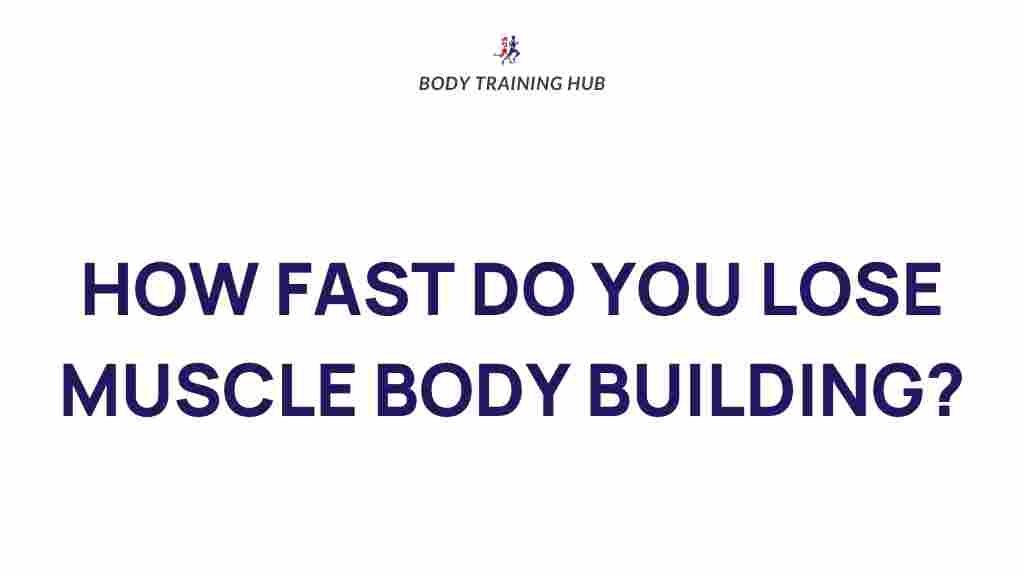Unveiling the Truth: The Science Behind Muscle Loss in Bodybuilding
Bodybuilding is an intricate art that combines science, discipline, and physical prowess. However, one of the most concerning issues for bodybuilders is muscle loss, often referred to as muscle atrophy. Understanding the reasons behind muscle loss is crucial for anyone engaged in bodybuilding, as it can significantly impact performance and aesthetics. In this article, we will explore the various factors contributing to muscle loss, the importance of training intensity, and effective strategies for muscle recovery.
Understanding Muscle Loss in Bodybuilding
Muscle loss, or muscle atrophy, is a condition where muscle fibers decrease in size and strength. In the context of bodybuilding, this can happen for several reasons:
- Inadequate Nutrition: Not consuming enough calories or protein can lead to muscle breakdown.
- Insufficient Training Intensity: Lacking challenge in workouts can result in muscle adaptation and reduced growth.
- Overtraining: Excessive training without adequate rest can lead to muscle fatigue and atrophy.
- Injuries: Injuries can prevent consistent training and lead to muscle loss.
- Age: As we age, muscle mass naturally decreases, making it crucial to maintain an active lifestyle.
The Role of Training Intensity
Training intensity is a critical factor in preventing muscle loss. It refers to the amount of effort exerted during workouts. High-intensity training stimulates muscle fibers, promoting growth and strength. Here are some key points regarding training intensity:
- Progressive Overload: Gradually increasing weights and resistance forces the muscles to adapt, reducing the risk of atrophy.
- Variety in Workouts: Incorporating different exercises and rep ranges can challenge the muscles in new ways, fostering growth.
- Compound Movements: Exercises like squats, deadlifts, and bench presses engage multiple muscle groups, enhancing overall strength and size.
The Importance of Muscle Recovery
Recovery is often overlooked yet is vital in bodybuilding. Recovery allows the muscles to repair and grow after intense workouts. Here are some recovery strategies to consider:
- Proper Nutrition: Consuming a balanced diet rich in protein, carbohydrates, and healthy fats supports muscle repair.
- Sleep: Aim for 7-9 hours of quality sleep per night to optimize recovery.
- Hydration: Staying hydrated is essential for muscle function and recovery.
- Active Recovery: Engaging in low-intensity activities on rest days can promote blood flow and aid recovery.
Step-by-Step Process to Combat Muscle Loss
To effectively combat muscle loss in bodybuilding, follow these steps:
- Assess Your Diet: Ensure you are consuming enough calories and protein to support muscle maintenance and growth.
- Create a Balanced Workout Plan: Incorporate a mix of strength training, cardio, and flexibility workouts. Focus on compound exercises and progressively increase weights.
- Prioritize Recovery: Schedule rest days and ensure you are getting enough sleep and nutrition to support recovery.
- Monitor Your Progress: Keep track of your workouts, nutrition, and any changes in muscle mass. Adjust your plan as needed.
- Consult a Professional: If you’re experiencing significant muscle loss, consider consulting a nutritionist or trainer for personalized advice.
Troubleshooting Muscle Loss
If you find yourself facing unexpected muscle loss despite following a structured plan, consider these troubleshooting tips:
- Evaluate Your Training Program: Ensure your program includes adequate intensity and volume to stimulate muscle growth.
- Check Your Caloric Intake: Use a food diary to track your meals and ensure you’re in a caloric surplus.
- Identify Signs of Overtraining: Look out for symptoms like persistent fatigue, decreased performance, and increased injuries.
- Reassess Your Goals: Sometimes, unrealistic expectations can lead to frustration. Set achievable goals and adjust your plan accordingly.
- Stay Informed: Keep up with the latest research and trends in bodybuilding to ensure your methods are effective.
Conclusion
In conclusion, understanding the science behind muscle loss in bodybuilding is essential for anyone serious about their fitness journey. Factors like training intensity, recovery, and nutrition play pivotal roles in maintaining muscle mass. By implementing the strategies discussed in this article, bodybuilders can reduce the risk of muscle atrophy and enhance their performance. Remember, bodybuilding is a marathon, not a sprint; consistency and knowledge are your best allies.
For more detailed insights into bodybuilding nutrition, check out our comprehensive guide here.
Additionally, for external resources on muscle recovery techniques, visit this link.
This article is in the category Strength & Recovery and created by BodyTraining Team
